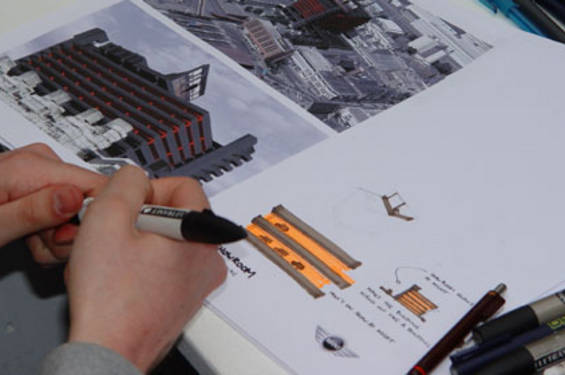This website uses cookies
This website uses cookies to enable it to function properly and to analyse how the website is used. Please click 'Close' to accept and continue using the website.



Cordula Zeidler
(An edited version of this text was published in the RIBA Journal, May 2005
Gateshead’s multi-story car park is one of Owen Luder’s great statements in concrete but just like his Tricorn Centre in Portsmouth it might soon be history. The impressive structure, built in 1967 as part of a shopping centre, stands out. To some it might be an eyesore as it contrasts with a new glamorous Gateshead just down the road, featuring the recently redeveloped riverside with Norman Foster’s Sage and the refurbished Baltic. The regeneration fever is spreading and Gateshead Council would like to see a European touch added to the city where the half-used car park still lingers. Reuse of the car park is not considered an option, and as the building isn’t listed little pressure can be put on from a conservation point of view. When it was built, the car park and the surrounding shopping centre were in turn thought to have a regenerative effect on the area but it now looks bleak for the building.
So far the only scheme put forward is by Tesco’s for yet another supermarket with, ironically, a new car park. But this satisfies no one. And while the existing building attracts local criticism, it is also deeply admired for its bold gesture and strong sculptural qualities. Due to its appearance in the 1970s film ‘Get Carter’ most Brits know the building. It is not just a good Brutalist chunk of concrete but also a part of British cultural history.
Following RIBAJ’s ‘recycling initiative’ (January 2005) the Department for Interior Architecture and Design at Nottingham Trent University decided to team up with the Twentieth Century Society and ask their students in a one-day workshop what they would do to save the building and breath new life into it. The building also features in SAVE Britain’s Heritage’s latest at risk register. We asked, could this not be another Baltic case?
Ideas are key when it comes to unused and underused buildings and an open minded and fresh approach is needed when looking at seemingly lost cases. We asked one hundred students which new uses might work for the car park and were rewarded with a broad range of ideas, from the now ubiquitous conversion into residential to entertainment venue, local sports facility and a green exhibition centre. This proved that asking students can provide interesting ideas and should be done more often.
The rather rigid structure of the main part of the building – seven identical floors with relatively low ceiling height – did not stop ambitious ideas. One team suggested some of the floor slabs could be broken up, new sloping ramps introduced and an ‘urban jungle’ for skaters and other urban sports be accommodated. A ‘green’ proposal for a recycling exhibition took an ethical approach to the problem of the building’s use; instead of the normal flow of cars travelling up the ramps, visitors would be driven around in karts made from recycled materials. One group did not want to part from the idea of motorism in the building and suggested a racing track for local youths who would make this their building. Other ideas were for a business exhibition centre, a social hub and shelter for people in need, and a yoga, spa and dance centre. Another team started off taking a very practical and incredibly bold approach to the current situation: the students acknowledged Tesco’s interest in the site, and accommodated their supermarket on the first two floors and a restaurant in the spectacular box on top of the building, with parking in between. This was a real eye-opener and showed that really all that is needed is already there! It also shows that conservation is more than saying ‘no’ to developments –it could be about saying yes to bright young ideas.
The students also thought about a brighter future for London’s Commonwealth Institute, Robert Matthew and Johnson-Marshall’s II* listed exhibition centre in Kensington. The building is under threat of de-listing through its owner, but the students showed that this does by no means need to be the end of a fantastic piece of architecture.
Links

Become a C20 member today and help save our modern design heritage.